Don’t Drip Food: How to Pre-Portion for Baby-Led Weaning
- What is dripping and why does it remove baby's autonomy from the eating process?
- How do we pre-portion a meal appropriately if there are no hard & fast baby portion sizes for foods?
- Why we want babies driving the pace of intake and how that helps them learn to recognize & respond to their own hunger & fullness cues
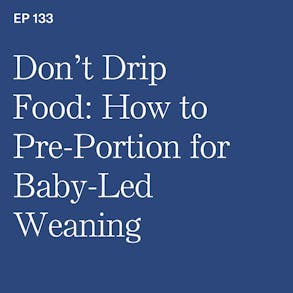
LISTEN TO THIS EPISODE
Episode Description
What’s the deal with dripping food? Dripping food is our control-freak way of regulating the pace of baby’s eating...and while it may seem harmless (and cleaner!) dripping can actually interfere with your baby’s ability to learn HOW to eat independently and to recognize and respond to their own hunger and fullness cues.
In this episode we’re talking about the draw-backs of dripping food piece by piece for baby-led weaning. Learning how to appropriately pre-portion your baby’s food is a better alternative to dripping and here’s how you do it!
Other Episodes Related to this Topic
- Episode 6: What Shape & Size Should My Baby’s Food Be at First?
- Episode 16: 10 Easy Starter Foods for Baby-Led Weaning
- Episode 25: Schedule for First 5 Days of Baby-Led Weaning
Links from this Episode
- TRY the ezpz Mini Mats, the 3-portion silicone suction mat mentioned in this episode. I use the 4-oz portion for the starchy/carbohydrate foods and each of the smaller 2 oz portions for 1 small serving of protein and 1 small serving of fruit or vegetable. You can get 10% off everything at ezpzfun.com with the code KATIE10 and this is my affiliate code.
- Baby-Led Weaning with Katie Ferraro program with the 100 First Foods™ Daily Meal Plan, join here: https://babyledweaning.co/program
- Baby-Led Weaning for Beginners free online workshop with 100 First Foods™ list to all attendees, register here: https://babyledweaning.co/baby-led-weaning-for-beginners

Latest Episodes
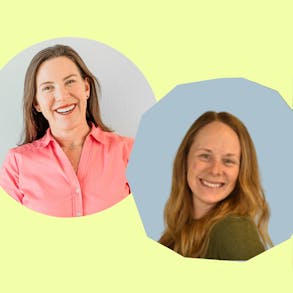
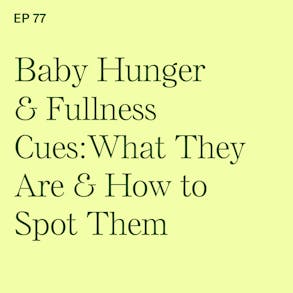
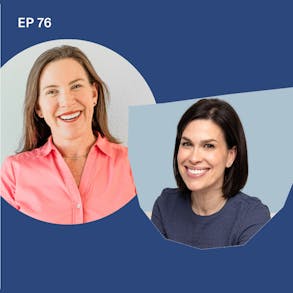
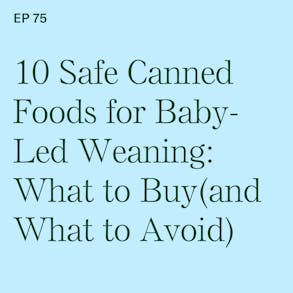
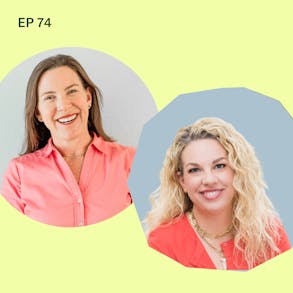

The problem with dripping is that you're the one essentially driving the pace of eating. You've removed your babies autonomy to regulate their own intake. You're drifting out of your lane. It's not your job to wait until piece one has done before you offer piece two. pre portioning meals removes all of these mistakes. Hey there, I'm Katie Ferraro, Registered Dietitian, college nutrition professor, and mama of seven specializing in baby led weaning. Here on the Baby-Led Weaning Made Easy podcast I help you strip out all of the noise and nonsense about feeding, leaving you with the competence and knowledge you need to give your baby a safe start to solid foods using baby led weaning.
Katie Ferraro (42s):
But Hey guys, and welcome back today we're talking about Dripping food versus pre portioning your babies food when your doing baby led weaning. And if you're not exactly sure what Dripping is or why it's not a preferred practice for baby led weaning, don't worry. I've got you covered. There are definitely benefits to the alternative, which is pre portioning, which is putting out the amount of food you think you're baby is going to eat. And in this episode, I'm going to share why we want to steer clear of Dripping. Now, when I do these mini baby led weaning training episodes, I always like to start with a BLW tip of the day. And today's tip is to please remember. There are no exact portion sizes of foods that babies should eat.
Katie Ferraro (1m 27s):
Parents ask me all the time. Can I get up baby led weaning portion guide? And they say, no, sorry, just don't do it. Why? Because there is no evidence backed set amounts of foods that babies have to eat. Please know, when you hear bloggers or other people and social media, or claiming that they've got these BLW portion guides just know that there are 100% arbitrary and completely made up. And when we make up things like this, all it does is make parents feel bad. What if my baby used and eating two ounces of legumes a day or a third of cup of soft cooked vegetables or one ounce of cooked meat, guess what? That's fine. Remember, babies need time to learn how to eat. And especially early on in the weaning process, the amount of food that your baby is eating does not matter.
Katie Ferraro (2m 14s):
So please do not unnecessarily stress yourself out about how much your baby is eating let's instead focus on the process of letting your babies learn how to eat. And one thing we want to avoid in the process is dripping. Now hang tight because I'm going to be sharing some ideas about what you might expect a baby to eat. But again, you're never going to get a hard and fast BLW portion guide for me because every meal is different. Every day is different. Every baby is different. And if we follow Ellyn Satter the noted dietician and family therapist, her division of responsibility in feeding theory, remember that it says that we as parents have jobs, we're in charge of what the baby eats and when they eat and where they eat.
Katie Ferraro (2m 57s):
But ultimately it is up to the baby to determine how, or even whether the baby eats. And so when we start forcing the baby to eat a set amount of food, because some arbitrary portion guide we got off of Instagram tells us too, we are not doing our job. So let's stay in our lane, do our jobs again, parents focus on what and where, and when the babies eat, but our babies ultimately determine how much they eat. So let's talk a little bit about Dripping. What is dripping and dripping? No, we don't want to do with baby led weaning. And here's what Dripping is your sitting in front of your baby. And you've got to play the food in your lap and you take a piece of food and you put it out in front and the baby and you sit there and the baby picks it up and the baby takes the food and puts it in his mouth.
Katie Ferraro (3m 37s):
And then you take another piece of food and you put it out and the baby picks it up and puts it in their mouth. That's dripping, dripping is, where we, as the parent's are controlling the pace of eating because ultimately we're controlling the availability of the food, right? We're putting it out on our schedule versus allowing the baby to be picking up the food's and putting it in their mouth on their schedule. So what is the drawback of Dripping? So when we drip foods, like I just described, what happens is it interferes with your babies, visual processes of learning, how to eat and learning how to eventually respond to their emerging hunger cues, because maybe you've heard that learning how to eat is an incredibly sensory experience, right?
Katie Ferraro (4m 19s):
It's not just about tasting the food. It's about smelling the food and feeling the food and listening to the sounds of eating, but also seeing the quantity of food and starting to learn how to regulate the movement of that food into the body in order to satisfy their hunger cues. And that's what we want, right? We want our baby's to actually end up being the term that's. So trendy is and intuitive eater, right? Parents spend a lot of money. Adults spend tons of money every year, learning how to it, to retrain themselves to be intuitive eaters. Like they were the two and they were a baby. Let's allow the baby to learn how to listen, to recognize and respond to their own hunger ques and then to also pace the intake of food.
Katie Ferraro (4m 60s):
Because if we're pushing the food in a set pace, that's essentially the same as spoonfeeding with the exception of, we might not be putting it in the baby's mouth, but we don't want to be the ones arbitrarily, but picking the pace at which the baby eats. So what's the alternative to Dripping the alternative dripping food. And what we want to do is to pre-portioned the amount of food that we think the baby will eat at a given meal. No first are gonna be like, but it never done this. I dunno how much it, maybe the week we can talk about some expectations about portion sizes, but please know that once you start doing this and you start feeding her baby one to two times at six to seven months and two to three times a day at eight to nine months, and then three times a day at 10 months of age with practice, you will gain progress as far as understanding how much your baby needs and wants.
Katie Ferraro (5m 43s):
And you'll learn how to listen. You too, and recognize your own baby's hunger cues. And you put the right amount of food out. But the point is we want to put the amount of food out that we think the baby is going to eat at the beginning of the meal. Now, if you're just really getting started and your like, I have no clue, like what it should look like that are a few other episodes that you might find helpful in order to put this dripping vs proportioning stuff. In context, if you listen to episode number six, it's called what shape and size should my baby's food be. At first, that's a really helpful place to start. And then they also have a schedule for the first five days of baby led weaning. That's on episode 25, as well as 10 easy starter foods Led Weaning and that's on episode 16. So I'm going to link all of those other episodes in the show notes for this Dripping episode.
Katie Ferraro (6m 26s):
And you can find that all at blwpodcast.com slash one, three, three. So back to the pre portioning, I teach a five step feeding framework where each day we introduce just one new food to our baby five days a week. That's five new foods a week. It's 20 foods a month in five months of your baby has consumed a hundred different foods. And we know that the research shows us that babies who are exposed to the greatest variety of foods and flavors and tastes and textures, they're more likely to be independent eaters and less likely to be picky eaters. So we want your baby to be getting in this rotation even very early on where you introduce one new food. And what will generally do is take a 20 minute feeding session and spend the first 10 minutes introducing the new food of the data to the baby.
Katie Ferraro (7m 7s):
And then in the second 10 minutes, what I'll do is I'll bring in a mat that has three foods on it, the new food from today, the one they just tried 10 minutes ago for the first time they hear it is again, along with, to familiar foods from to previous days. So I use a pre-portioned suction mat called the mini mat. It's from the company, you know, ezpz. They make the original silicone suction mattes. And those the mini-mat is perfect. Even if you're just starting out solid foods with you a month old, it has to do two ounce portion pocket's and one, four ounce, a portion pocket. It saved, shaped like a smiley face. So I'll put the new food of it. And one in the pockets and to familiar foods from the previous in the, to other pockets and the smiley face, the mouth is a little bit bigger.
Katie Ferraro (7m 48s):
The four ounce portion, I tend to put the carbohydrate or the starchy food. If I'm feeding up one starch, one small portion protein, and one small portion of a fruit or a vegetable. I put the starchy portion on the smiley face, smaller portion of protein. And, and the, the other small portion is a small portion of the fruit or vegetable. And you don't do it. Fruits and vegetables at the same time, I'll do one or the other. So we don't want to offer more than three foods at a time to the baby. That can be very overwhelming, but those portion pockets, some parents will fill them all the way up and just, no, you really don't have to. You, you just have to offer a few pieces. It was a few strips. Maybe half of the portion pocket could be full with food. Again, do you get going? And you'll start to recognize what you're baby can do it. She wants to eat. So you can put that plate out with a three different foods.
Katie Ferraro (8m 32s):
Then allow your baby 10 minutes, uninterrupted. Don't talk to your baby. Don't congratulate them. Don't wipe them slumped down and needed to be readjusted are, if you need to interfere for safety, course, you need to do that. But for the most part, we, as parents tend to micro manage the whole eating experience led that baby eat and peace, 10 minutes sniffing it, smelling it, smushing it again there, seeing it. It's all part of that visual process. So put out the amount of that. You think the baby will eat the three compartment mat again, that I like the mini mat from ezpz. I have an affiliate discount code for them. It's Katie 10. You can get 10% off all of the products at ezpzfun.com. They actually have lids now for each of those mats in the bowls. So if you want it pre portion of these meals, if you send a baby to daycare or do you have a sitter, are someone helps you are.
Katie Ferraro (9m 16s):
You're just trying to stay organized. You can put your meals together. And like I put the lids on them, pop them in the fridge, warm and backup. Let them cool to room temperature. So you're not burning your baby's mouth. And then put that plate out in front of them so that they get to see the amount of food and they can regulate which food they pick up first, which one they put in their mouth, how fast they do it. It might not seem like a big deal to you, but to your baby, being able to see the amount of food is important as part of the learning process vs. You, keeping them guessing when your holding the plate of food in your lab and kind of portioning out the food as you go. So again, we want to avoid Dripping. We do want to stick it to proportioning. The question. Parents are always ask us, well, what if my baby wants more?
Katie Ferraro (9m 59s):
There are some days, especially when you get in the nine and 10 month, mark of baby led weaning. It's kind of the golden age of baby led weaning. They're really into it. Oh, they might want a second plate of food. I know for those of you with multiples, then when I was feeding my quadruplets, and then later in my twins, one, maybe you might eat twice as much as another baby. And the next meal that other baby might eat two times as much as the different baby. And you kind of need to sit there and respond to those queues, but your not like doing it every single second, you can sit down and chill for 10 minutes and you always wanna watch the baby. But when I say chill it doesn't mean to get your phone out and leaving and the room, right? 'cause if a baby is going to choke, it will be a silent experience. You need to be right there observing the baby, but you don't need to be intervening and interfering with the baby's eating process, let them and go for a while. And then if you think they want more, you can bring out a little bit more another plate and you know, kind of learn to anticipate how much you think your baby you might want.
Katie Ferraro (10m 45s):
But of course what they ate yesterday, it might be totally different than what they eat the next day. What type of parents tend to drip food? To be honest, it's the ones you are very, very, very tight. A and I say that as a very, very type a person, but the person that wants to be in there. Yeah. I don't want the babies to make a mess. I want to make sure that they don't waste any of the food that I made. And I understand those concerns, but please know that making a mess is part of learning how to eat. So if you put three types of food out there, they might not eat all of it. They might smash some of it. They might smash some of it. They might play with some of it, but that's all part of the process of learning how to eat. I would encourage you to wipe your baby as your baby is eating. Cause that can be very negative, sensory it experience just to try to relax for 10 minutes. And I know it's easier said than done.
Katie Ferraro (11m 25s):
That's like when your trying to get pregnant, people tell you to just relax and it will happen. Like I've heard that. Thank you. That's not helpful. Just relax. When your babies learning how to eat. I know I should, but please know, you're baby can sense your stress. And so we want to create to the greatest extent possible a stress-free feeding environment. So if we can put in the food out, I put it out in front of the baby, observe them while they're eating, but try not to intervene. You're baby will then be gathering those experiences. And every single day, one to two times a day at six to seven months, two to three times a day at eight to nine months feeding her baby three times a day at 10 months, those little baby steps, all kinds of compound and then weaning really takes off. And so you're a baby will get the hang of feeding themselves. I know it can seem very Rocky at the beginning.
Katie Ferraro (12m 6s):
I know it can seem silly to put food out there and you're like, there's no way they're going to eat all this. And we don't want to have mounds of food. Okay? Generally, if you're working with a mini mat, which is two ounces to ounces and four ounces fill each one of them about halfway up, but again, you don't need to be measuring food. You don't need to be weighing food. If your offering a variety of foods and following that five, step it feeding a framework can help you stay in that rotation where you're baby is trying when new food today, but then your continuing to reintroduce the familiar foods from previous days. If you're interested in learning more about the five step feeding framework and the basics of starting out solid foods safely with baby led weaning, I teach a free online workshop every week. It's called baby LED WEANING FOR BEGINNERS. It's all about how to get your baby to eat 100 foods before turning one, without you having to spoonfeed purees or buy pouches.
Katie Ferraro (12m 50s):
And everyone on that free workshop gets a copy of my hundred first foods list. So you'll have a list of each of the five categories with 20 foods in each one, you'll know how to rotate through them. The next thing you know, you'll be proportioning foods like a pro. You won't have to deal with Dripping. You'll be raising an independent eater and preventing picky eating. You can get signed up for this week's free baby LED WEANING FOR BEGINNERS workshop. If you go to the show notes for this episode, which is at blwpodcast.com forward slash one three, three, thanks so much for listening. Bye now!

The Program Baby-Led Weaning with Katie Ferraro
A step-by-step digital program for starting solid foods safely and navigating the original 100 FIRST FOODS™ meal plan with baby-led weaning.
 EXPERT-LED, PROVEN APPROACH TO EATING REAL FOOD
EXPERT-LED, PROVEN APPROACH TO EATING REAL FOOD CONCISE VIDEO TRAININGS TO MASTER BABY-LED WEANING
CONCISE VIDEO TRAININGS TO MASTER BABY-LED WEANING 100 FIRST FOODS DAILY MEAL PLAN WITH FOOD PREP VIDEOS
100 FIRST FOODS DAILY MEAL PLAN WITH FOOD PREP VIDEOS
Baby-Led Weaning for Beginners Free Workshop
Is your baby ready to start solid foods, but you’re not sure where to start? Get ready to give your baby a solid foundation to a lifetime of loving real food…even if you’re feeling overwhelmed or confused about this next stage of infant feeding.
Get baby-led weaning recipes and tips delivered to your email inbox.

